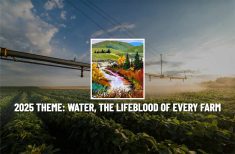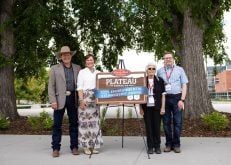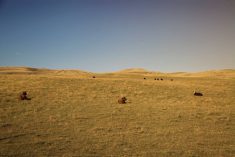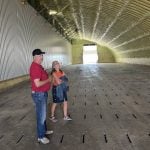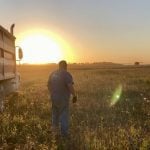Jenaya Roseboom is the senior winner of this year’s Alberta Young Speakers for Agriculture competition. The 20-year-old lives on a dairy farm near Rimbey, and in her speech, she addressed the question: Is local food sustainable?
There is no simple answer to this question.
Read Also

Men’s mental health advocate says sharing personal stories and communicating crucial to mental health
Former professional hockey player says awareness and support for men’s mental health is improving, but there is still a long way to go.
In agriculture, sustainability is a complex issue that has many parameters under which it can be defined. Today I am going to focus on three aspects of sustainability: environmental; social; and economic. Each aspect in its own right presents unique challenges to any sector of agriculture, as sustainability is a topic that is constantly evolving to include new concerns, information and solutions.
Environmental sustainability is the pursuit of a future that preserves the current resources and system functioning of the world.
I had the privilege of working at the Agriculture and Agri-Food Canada Research Station in Lacombe this summer. The primary focus of the various research projects I helped with is to encourage regenerative farming and to look for opportunities within current agricultural systems to improve our environmental impact while providing economic benefits to domestic farmers.
Local Alberta food sources fail to compare with national and global food sources when addressing these issues, yet there are many ways in which producers of local food continue to strive to do better for the environment.
One of the challenges local farmers face is to ensure that their tons per acre are produced as efficiently as possible to minimize land use. Other food sources in warmer climates do not have to battle with this type of productivity, as local farmers face extreme climates and short growing seasons.
However, many of the current projects I have had the pleasure of assisting with are focused on improving land-use efficiency, including a pasture rejuvenation project under Dr. Vern Baron that aims to increase hay and pasture yields in old stands.
Another popular misconception regarding local food is that it creates less carbon dioxide emissions because it has to travel less distance. This, however, is false considering the food-to-fuel ratio that is used to transport this food.
Considering this, research is being done for local farms to examine how the carbon cycle plays a role in this through the pasture rejuvenation project at the research station. This project focuses its efforts around carbon sequestration and uses biogeochemical cycles as a factor of soil health and production quality.
Local farming also allows for variability in creating more sustainable practices as there can be many innovative approaches to tackling sustainability.
Overall, at the forefront of a young person’s mind is the environment and for good reason. We as a society are hyper-aware of the need to invest in our future. In 1910, renowned environmentalist Gifford Pinchot perfectly encapsulated how we should use our resources when he wrote, “for the greatest good, for the greatest number and for the longest time.”
This idea should be applied to how we, as local farmers, engage in agricultural practices.
Farming is a lifestyle, and as such, it has deep cultural roots for many people in Alberta. However, when I first started going to university in Edmonton, I met many people who came from very different backgrounds.
For example, I had to teach one roommate that you cannot, in fact, milk “male cows.” To another roommate, I had to explain that my farm fresh eggs were not rotten because of their blue shell and that not all eggs are uniformly white or brown like you see at the grocery store.
These experiences gave me a first-hand look at the disconnection from where our food comes from.
It also highlighted for me the importance of education regarding agriculture, especially within a local setting. Education, social media, farm tours and relationships with the public must be maintained by local farmers to be sustainable. Celebrating our culture through events like these will continue to bring attention to our way of life.
More than culture, local farming encourages a sense of accountability and adherence to communal values. This means that local food can ensure a quality standard in terms of labour, animal health, and giving back to the environment and the community.
So, it is paramount that relationships must be built in order for the consumer to make informed choices about the local food they consume. Community involvement also provides support to farmers who face mental health challenges as farming is a high stress and isolating profession. Community is also paramount as local farmers rely on their neighbours to collaborate with and encourage new approaches and provide a helping hand when times are tough.
Sustainable practices must keep in mind that people must also thrive.
As such, there must be a balance between the economy and more conscientious concerns, in a way that is not exploitive but also allows humans to utilize natural resources.
Local agriculture presents an interesting paradox in which food is necessary to survive, but growing it on expensive land can make it difficult to survive in an economic sense.
As the industry evolves, young farmers are becoming extinct as the economic burden associated with farming becomes intimidating to manage. Not only that, but imported food increases purchasing power, which is incredibly more empowering for low-income families.
This social benefit cannot be ignored as the costs of living continue to rise.
Considering these points, one has to wonder how local farmers continue to survive. There are systems in place to assist farmers with their economic burdens such as the quota system for Canadian dairy, which helps smaller, local farms take up space within the industry by guaranteeing milk shipment from the farm.
Another important point when considering economic sustainability is the ability to be self-sustaining in times of crisis, as many residents of Nova Scotia found out. Food security is already a common international concern, so when the COVID-19 pandemic hit, many communities within Nova Scotia were struggling with supply chain issues and there were many food shortages due to their reliance on imported food.
Since then, there has been an emphasis on supporting local food so that Nova Scotia communities have a better sense of food security amid challenging circumstances.
Although this exact situation may not apply to land-locked, agriculturally rich Alberta, it does serve as an important reminder that there are vulnerabilities associated with imported and corporate-dominated food.
In conclusion, the local agriculture industry has to face many challenges associated with environmental, societal and financial stability.
Although many practices we use now are unsustainable, farmers are eager to seize opportunities to evolve. Local farming may not be largely sustainable now, but science, as well as the pure grit and heart of local farmers, will continue to see the future of agriculture grow and evolve.





